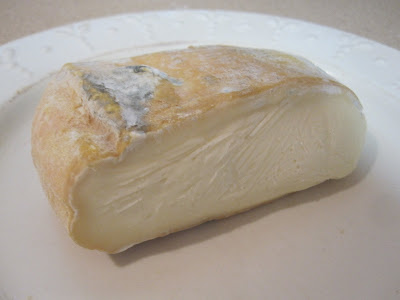Taleggio is a washed rind and smear-ripened cheese made originally in the Val Taleggio, an alpine valley in the Bergamo province of the region of Lombardy in northern Italy.
Until the early 20th century it was known as a type of "stracchino," a cheese made from milk of cattle tired after drives from the alpine pastures into the valleys. Specifically, it was known as "Stracchino quadro di Milano." Documents first mention the cheese in about the year 1200, but it is believed to go back to the 10th century. In 1914 it became known as "Stracchino quadro di Taleggio" and about ten years later became known as "Taleggio." It was given PDO (protected designation of origin) status in 1996. The best Taleggio is supposed to come from the Valsassina foothills in the Como province north of Bergamo where the growth of mold on the rind and maturation is benefited by the conditions of the caves where it is ripened and aged.
Taleggio is made from cow's milk, which may or may not be pasteurized, that is heated to approximately 91 degrees after which fermented milk and rennet is added. It coagulates in about 15 minutes. The curd is then broken into the size of hazelnuts and placed in 8 inch square metal molds and placed in rooms or caves at about 75 degrees and 90% humidity. The cheese is removed from molds and salted or brined with a solution that includes a mold and bacteria. The brining process continues weekly while it is aged for 35 to 40 days, where the mold is scraped and pressed back into the cheese, which causes it to develop the rind.
The rind is alternately described as a "rosy," "pink-gold" or "burnished orange-brown" color with dark mold spots and the flesh is white or straw-colored with some small holes.
Sources variously describe the taste as: a "sweet, slightly acidic, and aromatic with an aftertaste of truffle"; a "meaty richness, accented with yeasty, fruity qualities and a tangy, salty bite"; "an extremely pungent aroma, redolent with mushrooms, yeast and earth"; and 1001 Foods You Must Taste Before You Die describes it as "meaty, beefy, mushroomy, fruity, nutty, and salty, all at once." In our own taste test, I found it to have a bit of a musty smell, and a bit of a musty taste, particularly near the rind, which I ate. It is very creamy or buttery and mild. I actually preferred the taste near the rind because of the extra flavor. Judy compared it to Brie, but liked the Brie a little more, as comparatively, the Taleggio was a little bitter.




No comments:
Post a Comment